How does organic matter affect the physical and mechanical properties of forest soil?
Ehsan Abdi•Shojaat Babapour•Baris Majnounian•Ghavamodin Zahedi Amiri•Azade Deljouei
Introduction
Forest ecosystems are one of the most complex ecosystems in the world.In addition to providing wood for industrial uses and fuel,they are the most important factor in the sustainability of other critical ecosystems around the world.Forest roads facilitate log transportation,decrease costs and provide access to apply silvicultural techniques.They also have other important roles such as forest protection(e.g.,against fire)and tourism opportunities.However,it is the construction of forest roads that has the largest ecological impact on forests and causes the most changes.Much of the loss and damage from their construction is related to erosion and sediment production.Among the many types of erosion,landslides affect forest roads the most frequently,especially in steep forest regions,where they can destroy the roads,halting the wood extraction process,with severe economic and environmentalnegative consequences.Megahan et al.(1978)inventoried 1418 landslides around forest roads in the United States and assessed the effect of factors such as road standard,cross drain density,soil organic matter content and vegetation cover on landslide occurrence.As regards organic matter content,they found that landslides were most common 4–10 years after road construction,perhaps as a result of decomposition of organic matter in the road itself,thus causing soil settlement.Also,the Forestry Training Center Inc.(Forestry Training Centre Incorporated 2010)stated,‘‘Organic matter should not be considered for road fill material because it is unstable and will continue to decompose and lose its shape,and therefore provide little strength to the subgrade’’.
Awareness of the geotechnical and mechanical properties of soil is crucial for determining the vulnerability of road infrastructures and thus mitigating damage.Different soil types behave variously and vary in their suitability as a construction material.Understanding the behavior of soil and its mechanical properties is crucial for forest road management and ensuring permanent infrastructure serviceability.In forests,however,usually in situ soil is used as a construction material for subgrades and embankments;therefore,road structure may fail due to the stress of vehicle weight or soil settlement,and common problems such as pothole and wheel ruts can quickly develop.However,in the Hyrcanian forest with fine-grained cohesive soils that have poor engineering capabilities(e.g.,CL and CH soil types in the Uni fied Soil Classi fication System[USCS]),the subgrade alone often cannot bear the stress of traffic and must be stabilized using proper and cost effective techniques such as lime or polymer stabilization.The type and behavior of the soil that forms the roadbed in fluence the type of major problems that affect forest roads(e.g.,instability,potholes and wheel ruts).
Soil is the most available material that humans use,but owing to its mechanical behavior,it is among the most complex material.Fine-grained cohesive soils especially can behave unpredictably after water absorption.Forest soils are heterogeneous;thus,determining the characteristics of the soil in different parts of the road is essential,but forest engineers do not often study soil mechanics.Boston et al.(2008)found that uncontrolled compaction in the United States road system produced a low density soil with a high water content,conferring a soil strength that was significantly less than the potential for these soils.
The most important reason that soil properties in forests and natural resources are neglected is the lack of adequate supervision during road construction and insufficient attention to estimating the actual cost of forest road maintenance.Determining the mechanical properties of subgrade soil can guide engineers in building and managing a road to ensure its permanent serviceability.Such studies will reduce the total costs of road construction,maintenance and management(Fay et al.2012).
An important principle in forest road construction is to avoid the incorporation of organic matter into the road construction materialin subgrade and embankments because organic matter can adversely affect the strength and stability of the road.Organic soils create a dense,grainy soil structure with a high water holding capacity,and a high water content will reduce the soil’s California bearing ratio(CBR).Organic matter also reduces the quality and applicability of the soil for engineering(Malkawi et al.1999;Yildirim and Gunaydin 2011).The Forestry Training Centre Incorporated(2010)stated,‘‘Stumps and organic debris must be removed from the road surface prior to filling because organic debris does not compact well,it tends to settle,causing slumps in fill sub-grade’’.
Some researchers have noted the in fluence of organic matter on the behaviors of soil especially in fine-grained cohesive soils.Organic content was reported to have adverse in fluence soil qualities,e.g.,reducing bulk density(Soane 1990;Arvidsson 1998;Carter 2002),increasing plasticity or the Atterberg limits(Krizek et al.1975),decreasing maximum dry density(Holtz and Krizek 1970;Malkawi et al.1999),increasing optimum moisture content(Holtz and Krizek 1970;Malkawi et al.1999;Song et al.2003),and increasing water retention(Ohu et al.1985),and soil mechanical properties such as reducing the strength or soil CBR(Franklin et al.1973;Davies 1985;Ekwue 1990;Carter 2002;Ohu et al.2009).
However,Malkawi et al.(1999)stated that only a few studies have focused on the effect of small amounts organic matter on the properties of soils.Therefore,the main goal of the current work was to assess the effect of organic matter on the physical and mechanical behavior of soil,speci fically with regard to forest road construction.The other aim was to assess the relationship between different organic matter contents and soil properties.Due to the complex,uncontrollable conditions in forested areas compared with public highways,mixing organic matter and soil into road materials is more frequent,and we believe that demonstrating the adverse effects of soil incorporation may convince road designers to consider this factor during construction.The amount of organic matter mixed in with the soil in forest road construction mainly depends on litter thickness and the machines used for construction.Among the machines used,bulldozers contribute the highest rate of mixing due to their relatively low maneuvering capability.Based on our observations in the Hyrcanian forest,approximately 5–15%of organic matter may be mixed with subgrade and fillslope material during road construction by bulldozers.
Materials and methods
Study site
The Hyrcanian forest in northern Iran is a temperate deciduous forest and covers 1.9 million hectares.The study site is a part of central Hyrcanian forest(latitude:36°33′N,longitude:50°33′E).The site has an area of about 1080 ha,with 788 ha exploitable.The slope varies between 0 and 80%.The silviculture system is selection system and rubber skidder is used to transport logs.The length of road network is about 15.8 km and therefore the corresponding road density is 20 m/ha.The tree species of this forest areFagus orientalis,Carpinus betulus,Parrotia persica,Acer velutinum,Ulmus glabraandTaxus baccata.
Methods
An extensive part of the study area has high plasticity clay soil,the CH soil type,the most common type in the area(Majnounian 1990).The CH soil was thus sampled to investigate how organic matter content of soil changes the behavior of the soil.The required inorganic soil sample(as Table 1 shows,the natural organic content was 1.33%)was collected in the forest at a depth of 30–60 cm.The soil sample was air-dried for 14 days before testing.The particle size distribution(ASTM D422)of the sample is shown in Fig.1.
The sample had a high liquid limit(87.33%)and high plasticity index(42.95%)and was classi fied as a high plasticity clay or CH.Table 1 shows the chemical characteristics of the soil.
Organic matter was also gathered from the forest floor,then mixed and milled and passed through a 0.420 mm sieve to remove coarse particles(Malkawi et al.1999).Four soils,amended with varying amounts of the organic matter,were used for the tests:control(0%organic content),and 5,10 and 15%(percentage by mass)organic matter.These percentages were chosen based on our field determinations during road construction.Soil and organic matter were mixed and then wetted to reach half of the plastic limit(Malkawi et al.1999).Because the plastic limit was 44.38%,about 22%moisture was added to the mixture.To investigate the changes in the soil behavior due to the presence of organic matter in soil,we measure(according to ASTM 1992)soil plasticity including liquid limit and plastic limit(ASTM D4318),maximum dry density(ASTM D698)and CBR(ASTM D1883)for each of the soils.The tests were:soil plasticity including liquid limit and plastic limit(ASTM D4318),maximum dry density(ASTM D698)and CBR(ASTM D1883).As Malkawi et al.(1999)used two oven temperatures,60 and 110°C(for 24 h),to investigate the effect of oven drying temperature on the determined moisture content for slightly organic soils(amended with peat).Similarly,in the present study,we used both temperatures to determine water content in the four soils.

Table 1 Chemical characteristics of the soil sample
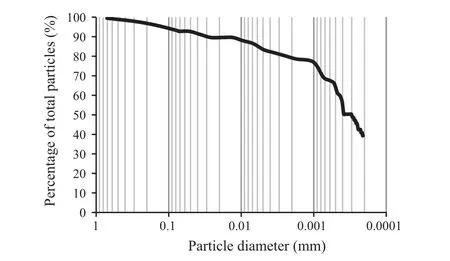
Fig.1 Particle size distribution of the test soil
Results
Soil plasticity
The results of plasticity tests(Table 2)that the organic matter content tended to increase soil plasticity.However,for the plasticity index,the trend was not uniform.
The results of a pairedttest showed signi ficant differences between the moisture content for the two drying temperatures with the higher moisture content for 110°C(p<0.001).Regarding the trends,the plasticity characteristics(except for the plasticity index)increased linearly with an increase in organic content after heating at 60 and 110°C(Fig.2).

Table 2 Soil plasticity(Atterberg limits)of soils amended with different amounts of organic content and heated at different temperatures
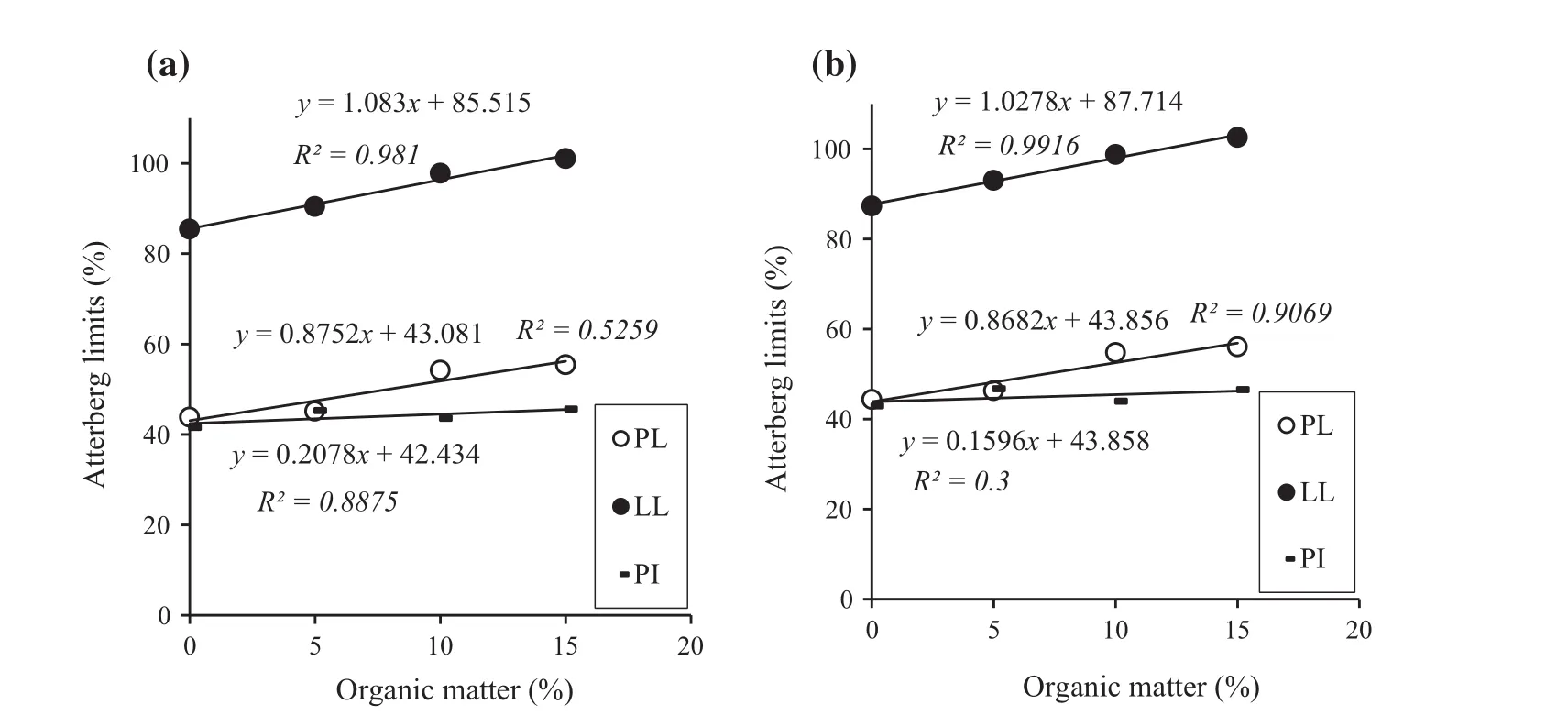
Fig.2 Relation of Atterberg limits to percentage of organic matter in soils after heating at 60 °C(a)or 110 °C(b)
Compaction
The effects of oven drying temperature on the results of the Proctor compaction tests are presented in Table 3.The results of a pairedttest showed signi ficant differences between the density and moisture of the two drying temperatures with the highest moisture content and lowest dry density for 110°C(p<0.001).
The results showed that,generally,increasing the organic matter content decreases the maximum dry density of the soil samples and increases optimum moisture content(Fig.3).
Effect of oven temperature on the determined properties of soil
Signi ficant differences were found between the two oven drying temperatures for the same mixture with lower water content values in the 60°C drying temperature,with differences ranging between 0.54 and 2.64%for Atterberg limits and from 0.4 to 2.0%for compaction tests.Although signi ficant,the differences were relatively lower compared with the results of Malkawi et al.(1999)with 2–9%for Atterberg limits and 1–3%for compaction results.

Table 3 Proctor compaction test results for control and treated soils at two temperatures
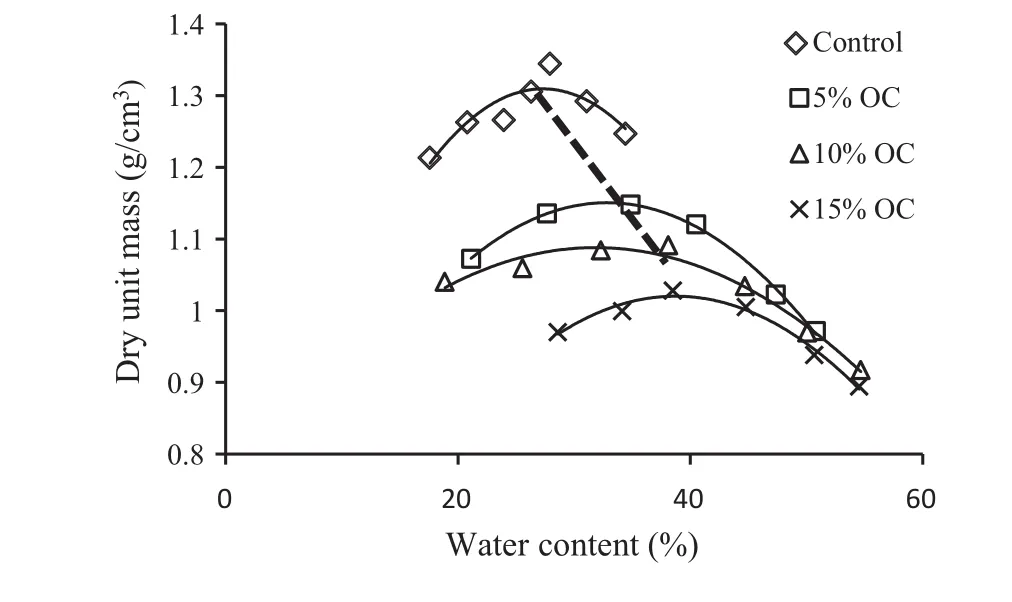
Fig.3 Proctor compaction curves for soils with different percentages of organic content(OC)(110°C).Dashed line shows the trend of decreasing maximum dry density and increasing optimum moisture content with increasing OC
California bearing ratio
The results of CBR(California bearing ratio)tests showed that increasing the organic matter content decreased the resistance of soil samples to penetration(Fig.4).
Therefore,there is an inverse relationship between the CBR and organic matter content(Table 4),i.e.,the CBR of the soil decreased with higher levels of organic matter in the soil.
Discussion
Plasticity is a property that measures a soil’s limits in terms of its ability to change into a solid or liquid form when water is applied.The limit to which a soil can adsorb water affects its ability to maintain its shape under changing conditions.The results revealed that the percentage of organic matter had a negative effect on the plasticity of the soil.Zhang(1994)reported that an increase in soil plasticity is due to the greater water-holding capacity and higher surface area of organic matter.Organic matter increases the capacity for water adsorption,enabling the soil to hold more water,i.e.,increase the plasticity of the soil.Our results are consistent with those of Odell et al.(1960)who found that plasticity limits of soil increase linearly with increasing organic content.Regarding the plasticity index,the results are inconsistent;Malkawi et al.(1999)reported that the plasticity index increased with higher organic matter,but Schmidt(1965)stated that the plasticity index is independent of the organic matter content.On the other hand,Zhang(1994)reported that the plasticity index slightly decreased with increasing organic content of soil.Our results showed that the plasticity index is relatively constant with increasing organic content.According to the plasticity indices(PI)studied,the soil was grouped as being very plastic(PI<35).That means the absorption and retention of water in the soil are high.Due to these properties,road work with these soils is dif ficult and expensive because the soil does not compact well and it sticks to the equipment,causing a problem.These aspects of organic soils make them poor construction material in terms of providing a sound foundation for construction.
Compaction curves showed that by increasing organic matter from 0 to 15%,the maximum dry density decreased from 1.31 to 1.02 g/cm3,and optimum moisture content increased from 27 to 38%(dashed line in Fig.3).These results are in accordance with those of Holtz and Krizek(1970)and Malkawi et al.(1999).On the one hand,the optimum moisturecontentincreaseswith increasing organic content of soil.On the other hand,the organic matter reduces the maximum dry density by holding more water,and because water cannot be compacted,it resists compaction efforts(Malkawi et al.1999).Thiyyakkandi and Annex(2001)attributed the increase in optimum moisture content to the changes in the plasticity characteristics of soil with organic content.
Different drying temperatures produced differences in the moisture contents of oven dried samples.Malkawi et al.(1999)concluded that a 110°C drying temperature is not considered too hot and that this oven temperature results in drier samples than those dried at 60°C.They reported that using 60 °C instead of 110 °C results in lower water content values which justify our results.Our results are consistent with this research,but the reason the ranges in our results are lower than those of Malkawi et al.(1999)may be related to the type of organic matter;Malkawi et al.(1999)used peat to amend the soil,and we used litter and dead tree parts.
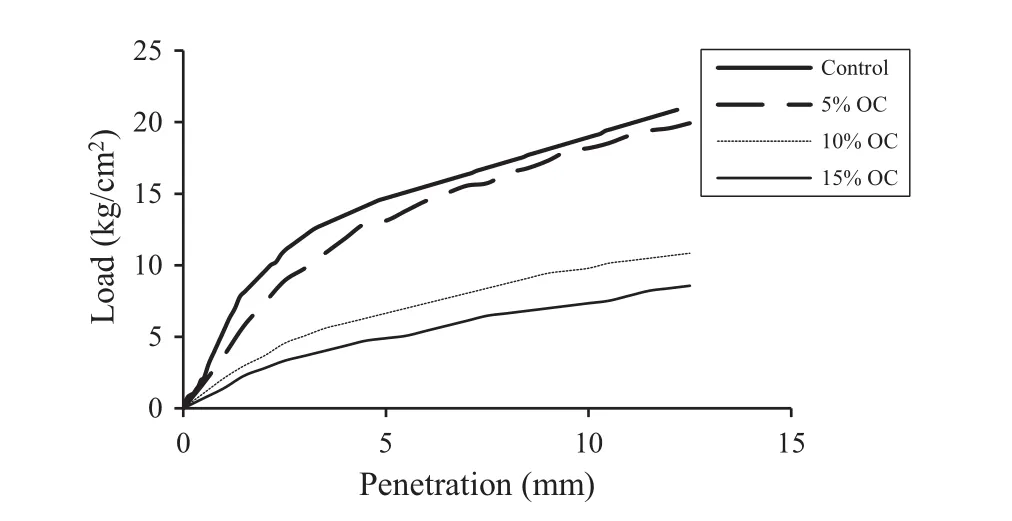
Fig.4 CBR test results for soils with different percentages of organic content

Table 4 Resulting CBR for different soil treatments
Previous studies concerning soil strength have shown that organic matter reduces the strength of soil(Low 1954;Williams and Cooke 1961;Greenland et al.1975;Ohu et al.1985,2009;Ekwue 1990;Carter 2002;Mitchell and Soga 2005).Our results revealed that there is an inverse relation between organic percentage and CBR of the soil we used.This inverse relation is attributed to the reduction in the maximum dry density of soil as a result of increasing organic matter content.
Conclusions
In our assessment of the in fluence of the percentage organic matter on the plasticity,compressibility characteristics and CBR of clay with high plasticity(CH),the results revealed that the organic content changed the behavior of the clay and adversely affected the behavior of the soil and thus its engineering suitability.With increasing organic content,the plasticity properties of the clay soil increased linearly.Organic matter had negative effect on the maximum dry density of the soil and increased the optimum moisture content.CBR and organic matter content were inversely related;CBR increased as organic content of soil decreased.We thus conclude that organic matter has a negative effect on the engineering behavior of soil for forest road construction even in relatively small amounts.Therefore,it is very important to keep organic matter out of the subgrade and avoid mixing organic matter with road materials during excavation and embankment construction.
References
American Society for Testing and Materials(ASTM)(1992)Annual book of ASTM standards.ASTM Publication,Philadelphia,p 464
Arvidsson J(1998)In fluence of soil texture and organic matter content on bulk density,air content,compression experiments.Soil Tillage Res 49:159–170
Boston K,Pyles M,Bord A(2008)Compaction of forest roads in Northwestern Oregon–room for improvement.Int J For Eng 19:24–28
Carter MR(2002)Soil quality for sustainable land management:organic matter and aggregation interactions that maintain soil functions.Agron J 94:38–47
Davies P(1985)In fluence of organic matter content,moisture status and time after reworking on soil shear strength.J Soil Sci 36:299–306
Ekwue EI(1990)Organic-matter effects on soil strength properties.Soil Tillage Res 16:289–290
Fay L,Akin M,Shi X(2012)Cost-effective and sustainable road slope stabilization and erosion control.Transportation Research Board Press,Washington,p 240
Forestry Training Centre Incorporated(2010)Introduction to forest roads and considerations for reduced impact logging.Tropical Forest Foundation press,Georgetown,Guyana,pp 14–85
Franklin AG,Orozco LF,Semrau R(1973)Compaction and strength of slightly organic soils.J Soil Mech Found Division 99:541–557 Greenland DJ,Rimmer D,Payne D(1975)Determination of the structural stability class of English and Welsh soils,using a water coherence test.J Soil Sci 26:294–303
Holtz RD,Krizek RJ(1970)Properties of slightly organic top soil.J Constr Division 96:29–43
Krizek RJ,Max WG,Paul LH (1975)Organic content and engineering behavior of typical maintenance dredging.In:Proceedings of the 4th south east Asian conference on soil engineering,southeast Asian society of soil engineering,Kuala Lumpur,pp.6–15
Low AJ(1954)The study of soil structure in the field and the laboratory.J Soil Sci 5:57–74
Majnounian B(1990)Assessing physical and mechanical properties of Kheirud forest soil,Final report.University of Tehran Press,Tehran,p 55
Malkawi AIH,Alawneh AS,Abu-Safaqah OT(1999)Effects of organic matter on the physical and the physicochemical properties of an illitic soil.Appl Clay Sci 14(5):257–278
Megahan WF,Day NF,Bliss TM(1978)Landslide occurrence in the western and central Northern Rocky Mountain physiographic province in Idaho.In:Proceedings of the 5th North American forest soils conference.Fort Collins,Colorado,pp.116–139
Mitchell J,Soga K(2005)Fundamentals of Soil Behavior.Wiley,Hoboken,New Jersey,p 592
Odell RT,Thornburn TH,Mckenzie LJ(1960)Relationships of Atterberg limits to some other properties of Illinois soils.Soil Sci Soc Am J 24(4):297–300
Ohu JO,Raghavan GSV,McKynes E(1985)Peatmoss effects on the physical and hydraulic characteristics of compacted soils.Am Soc Agric Biol Eng 28:420–424
Ohu JO,Mamman E,Mustapha AA(2009)Impact of organic material incorporation with soil in relation to their shear strength and water properties.Int Agrophys 23:155–162
Schmidt NO(1965)A study of the isolation of organic matter as a variable affecting properties of a soil,In:PhD Thesis.University of Illinois Press,Champaign,p 81
Soane BD(1990)The role of organic matter in soil compactibility,a review of some practical aspects.Soil Tillage Res 16:179–201
Song YS,Yun JM,Hong WP,Kim TH(2003)Investigation of solid waste soilasroad construction material.Environ Geol 44:203–209
Thiyyakkandi S,Annex S(2001)Effect of organic content on geotechnical properties of Kuttanad Clay.Electron J Geotech Eng 16:1653–1663
Williams RJB,Cooke GW(1961)Some effects of farmyard manure and of grass residues on soil structure.J Soil Sci 92:30–39
Yildirim B,Gunaydin O(2011)Estimation of California bearing ratio by using soft computing systems. Expert Syst Appl 38:6381–6391
Zhang H(1994)Organic matter incorporation affects mechanical properties of soil aggregates.Soil Tillage Res 31:263–275
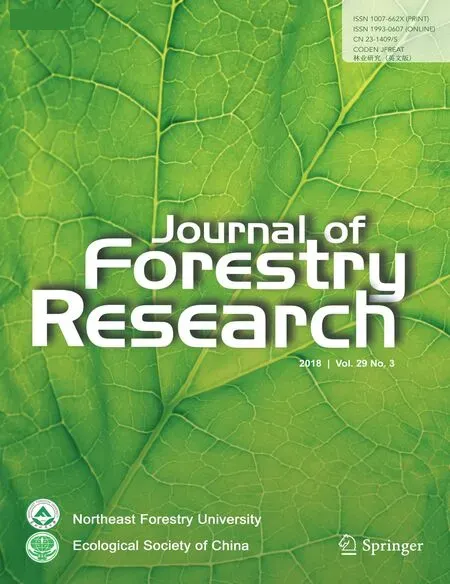 Journal of Forestry Research2018年3期
Journal of Forestry Research2018年3期
- Journal of Forestry Research的其它文章
- In vitro propagation of conifers using mature shoots
- ‘Relationships between relationships’in forest stands:intercepts and exponents analyses
- Effects of application date and rate of foliar-applied glyphosate on pine seedlings in Turkey
- Assaying the allelopathic effects of Eucalyptus camaldulensis in a nursery bed incorporated with leaf litter
- Effects of soil compaction on growth variables in Cappadocian maple(Acer cappadocicum)seedlings
- Variation and selection analysis of Pinus koraiensis clones in northeast China
